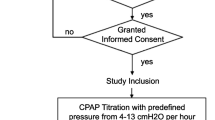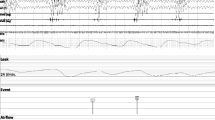Abstract
Respiratory events (RE) during sleep induce cortical arousals (A) and marked changes in autonomic markers in sleep apnea syndrome (SAS). The aims of the study were double. First, we assessed whether pulse wave amplitude (PWA) added to polysomnography (PSG) could improve RE and A detection; second, we wanted to know whether the quality of detection of these two parameters could be improved using PWA. Respiratory disturbance index (RDI) and A were randomly scored twice by the same observer in 12 male patients with SAS. The first scoring was done using conventional PSG signals, the second scoring adding PWA to PSG. We also measured interobserver agreement by randomly selecting and reading 100 PSG sequences of 5 min with and without PWA by two observers. Adding PWA to PSG parameters allowed to detect significantly more RDI (53.9 ± 21.6 h−1 versus 48.3 ± 22.3 h−1, p < 0.001) and more A (68.0 ± 14.4 versus 59.4 ± 16.5, p < 0.001). Moreover, after using PWA, there was no significant disagreement between two observers for detecting RE, showing better quality of RE detection. PWA is a simple and cheap parameter that improves the diagnostic value of conventional PSG in sleep apnea syndrome by better detecting respiratory events and A.



Similar content being viewed by others

References
Bresnitz EA, Goldberg R, Kosinski RM (1994) Epidemiology of obstructive sleep apnea. Epidemiol Rev 16(2):210–227
Olson LG, King MT, Hensley MJ, Saunders NA (1995) A community study of snoring and sleep-disordered breathing. Prevalence. Am J Respir Crit Care Med 152(2):711–716
Kripke DF, Ancoli-Israel S, Klauber MR, Wingard DL, Mason WJ, Mullaney DJ (1997) Prevalence of sleep-disordered breathing in ages 40–64 years: a population-based survey. Sleep 20(1):65–76
Bonnet MH (1993) Cognitive effects of sleep and sleep fragmentation. Sleep 16(8 Suppl):S65–S67
El-Ad B, Lavie P (2005) Effect of sleep apnea on cognition and mood. Int Rev Psychiatry 17(4):277–282
Martin SE, Wraith PK, Deary IJ, Douglas NJ (1997) The effect of nonvisible sleep fragmentation on daytime function. Am J Respir Crit Care Med 155(5):1596–1601
Norman RG, Pal I, Stewart C, Walsleben JA, Rapoport DM (2000) Interobserver agreement among sleep scorers from different centers in a large dataset. Sleep 23(7):901–908
Guilleminault C, Connolly S, Winkle R, Melvin K, Tilkian A (1984) Cyclical variation of the heart rate in sleep apnoea syndrome. Mechanisms, and usefulness of 24 h electrocardiography as a screening technique. Lancet 1(8369):126–131
Sforza E, Jouny C, Ibanez V (2000) Cardiac activation during arousal in humans: further evidence for hierarchy in the arousal response. Clin Neurophysiol 111(9):1611–1619
Davies RJ, Belt PJ, Roberts SJ, Ali NJ, Stradling JR (1993) Arterial blood pressure responses to graded transient arousal from sleep in normal humans. J Appl Physiol 74(3):1123–1130
Tauman R, O’Brien LM, Mast BT, Holbrook CR, Gozal D (2004) Peripheral arterial tonometry events and electroencephalographic arousals in children. Sleep 27(3):502–506
Schnall RP, Shlitner A, Sheffy J, Kedar R, Lavie P (1999) Periodic, profound peripheral vasoconstriction-a new marker of obstructive sleep apnea. Sleep 22(7):939–946
Pillar G, Bar A, Betito M et al (2003) An automatic ambulatory device for detection of AASM defined arousals from sleep: the WP100. Sleep Med 4(3):207–212
Pepin JL, Delavie N, Pin I et al (2005) Pulse transit time improves detection of sleep respiratory events and microarousals in children. Chest 127(3):722–730
Pitson D, Chhina N, Knijn S, van HM, Stradling J (1994) Changes in pulse transit time and pulse rate as markers of arousal from sleep in normal subjects. Clin Sci (Lond) 87(2):269–273
Pitson DJ, Stradling JR (1998) Value of beat-to-beat blood pressure changes, detected by pulse transit time, in the management of the obstructive sleep apnoea/hypopnoea syndrome. Eur Respir J 12(3):685–692
Catcheside PG, Chiong SC, Mercer J, Saunders NA, McEvoy RD (2002) Noninvasive cardiovascular markers of acoustically induced arousal from non-rapid-eye-movement sleep. Sleep 25(7):797–804
Haba-Rubio J, Darbellay G, Herrmann FR et al (2005) Obstructive sleep apnea syndrome: effect of respiratory events and arousal on pulse wave amplitude measured by photoplethysmography in NREM sleep. Sleep Breath 9(2):73–81
Johnson LC, Lubin A (1967) The orienting reflex during waking and sleeping. Electroencephalogr Clin Neurophysiol 22(1):11–21
Rechtschaffen A, Kales A (1968) A manual of standardized terminology, techniques and scoring system for sleep stages of human subjects. Brain Information Service, Barin Research Institute, UCLA, Los Angeles
(1992) EEG arousals: scoring rules and examples: a preliminary report from the Sleep Disorders Atlas Task Force of the American Sleep Disorders Association. Sleep 15(2):173–184
American Academy of Sleep Medicine Task Force (1999) Sleep-related breathing disorders in adults: recommendations for syndrome definition and measurement techniques in clinical research. The Report of an American Academy of Sleep Medicine Task Force. Sleep 22(5):667–689
Bland JM, Altman DG (1986) Statistical methods for assessing agreement between two methods of clinical measurement. Lancet 1(8476):307–310
Bland JM, Altman DG (2003) Applying the right statistics: analyses of measurement studies. Ultrasound Obstet Gynecol 22(1):85–93
Argod J, Pepin JL, Smith RP, Levy P (2000) Comparison of esophageal pressure with pulse transit time as a measure of respiratory effort for scoring obstructive nonapneic respiratory events. Am J Respir Crit Care Med 162(1):87–93
Tsai WH, Flemons WW, Whitelaw WA, Remmers JE (1999) A comparison of apnea-hypopnea indices derived from different definitions of hypopnea. Am J Respir Crit Care Med 159(1):43–48
Manser RL, Rochford P, Pierce RJ, Byrnes GB, Campbell DA (2001) Impact of different criteria for defining hypopneas in the apnea-hypopnea index. Chest 120(3):909–914
Loredo JS, Clausen JL, Ancoli-Israel S, Dimsdale JE (1999) Night-to-night arousal variability and interscorer reliability of arousal measurements. Sleep 22(7):916–920
Drinnan MJ, Murray A, Griffiths CJ, Gibson GJ (1998) Interobserver variability in recognizing arousal in respiratory sleep disorders. Am J Respir Crit Care Med 158(2):358–362
Acknowledgment
The authors thank the state of Valais and the Délégation Valaisanne de la Loterie Romande for the financial support and Michel Picard-Kossovsky for his help in statistical analysis. The authors declare that they have no conflict of interest.
Author information
Authors and Affiliations
Corresponding author
Rights and permissions
About this article
Cite this article
Zacharia, A., Haba-Rubio, J., Simon, R. et al. Sleep apnea syndrome: improved detection of respiratory events and cortical arousals using oxymetry pulse wave amplitude during polysomnography. Sleep Breath 12, 33–38 (2008). https://doi.org/10.1007/s11325-007-0126-x
Published:
Issue Date:
DOI: https://doi.org/10.1007/s11325-007-0126-x



